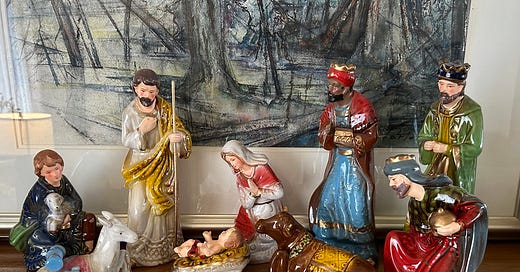The Star of Epiphany
After Christmas we enter the season of Epiphany, which means "manifestation". May we manifest climate justice this year.
Hello friends,
Happy New Year! I hope that you all had a meaningful Christmas. Technically we are still in Christmas on the day this is posted - it’s day 10 of the 12 days of Christmas! For that, you get ten lords leaping:

May 2025 bring us the delight and abandon we witness in this photo, amid our struggle for climate justice.
We are in a climate and ecological crisis, and it’s all hands on deck... Subscribe to join a community of people of faith who care about climate action and find hope and encouragement at the same time!
I’m still on vacation with my family, returning to my desk on Epiphany on January 6. Thus, I’m sharing a message about what Epiphany means, which I wrote two years ago (how is 2023 two years ago already?). Next week I’ll have a brand new essay reflecting upon my recent trip to Germany and the profound impact it had on my understanding of discipleship and commitment to climate action. See you then!
That Epiphany Star
On January 6 we begin the season of Epiphany in the Christian calendar. Epiphany is noted as the time when the magi, or the Wise Ones, followed the star and visited Jesus. Although the popular Christmas story has them gathered around the newborn Jesus, in reality, the journey would have taken approximately 3 years, and so Jesus would have been a walking, talking toddler by the time they met him.
This post is free for all subscribers. Need to find encouragement and hope in this time of climate and ecological crisis? Want to support this eco-ministry that is international and ecumenical? With a paid subscription you’ll get more of the encouragement you need, find hope in this difficult time, and make this ministry possible!
If a paid subscription is not for you right now but you’d like to make a one-time contribution, you can do so here!
Although January 6 is only 12 days after Christmas, I appreciate the slowing of time in this more accurate telling of the story: When we celebrate Epiphany, we acknowledge that the birth of Jesus into the world wasn’t just about God coming into the world through a baby, but is about the manifestation, the epiphany, of something entirely new and unpredicted into our world, forever changing the world for people of faith.
We don’t have to be at the manger of the newborn for this to be true. We can follow the star that shows the way, lights the path, and brings us to Jesus, to God incarnate, in whatever time it takes. For the magi, it took 3 years. This does not belie the truth of the Christmas story; instead, it makes it all the more powerful, moving us past the saccharine version of a sweet innocent baby, and into the more compelling, dangerous, status-quo-upheaving truth of the incarnation. Remember: the magi had to strategize to avoid leading Herod to Jesus, who wanted to kill him. They went back a different way to their homes than they had come, in order to keep Herod away.
Epiphany is celebrated on January 6 but is recognized as a season that we live in until Lent. What does it mean that we are in the season of Epiphany? What does it mean for us to recognize the birth of the light into the world through Jesus, the manifestation of God in our world? What does it mean to recognize the manifestation of God within the Earth community?
To me, as an ecotheologian and minister, this is the question that I am sitting with. I am struck, this year, by the fact that it was a star, a star in the sky, that led the magi to Jesus. It was a star, born into existence through the dynamics of the universe, that led them to Jesus. It was a star, from so far away that it defies comprehension, that the magi saw and followed.
It was a star, one star among many billions, that led them to the Incarnate One. A star, borne out of the same elements as the planets and the sun, and all of life on Earth. The same elements as you and me; the same elements as Jesus himself.
What does this mean? What dimension and wisdom can it bring to our understanding of Epiphany, to our understanding of the journey of the magi, to our understanding of the manifestation of God into the world? What does it mean that it was a star, moving forward through billions of miles and billions of years to be seen by the magi, that led them to the Incarnate One? What does it mean that this star was made up of the very same elements that exist in you and me, and existed in Jesus? (And, whether you believe this story is literally true or not, the fact is that this is the way that the story has been told, all through the generations of our ancestors in faith. So, these questions of the story itself still hold.)
Friends, I invite you to sit with these questions and reflect upon them. If you feel so inspired, I would love to hear from you, about what comes up! This is the season of Epiphany; as the magi return to their homelands, forever changed by what they saw and experienced in meeting Jesus, let us reflect, pray, and think, about what the Epiphany means for us in our time, in our world, within Earth community.







